Growing Up Poor
Paul William Bryant was born a place near Fordyce, Arkansas called Morro Bottom on September 11, 1913. Born the eleventh of twelve children, his family was poor and worked hard to eak out a meager existance. Young Paul Bryant quickly found himself behind a plow every morning before school and then back behind it again until sunset. On the weekends, both he and his mother would drive a mule and wagon to the nearby town of Fordyce to sell produce.
Of his childhood, Bryant said, "The one thing I disliked most about growing up was getting up every Saturday, hitching up our mule to our wagon and going to Fordyce with Mama. I didn't mind the work. In fact, I'd love to be with Mama again doing that today. What I hated about it was coming face-to-face with the people we met along the way. I had an inferiority complex. I didn't feel like I was as good as those people. I thought they looked down on me."
Years of hard work left Bryant strong and it seems a little hard-headed. One day, a man in a covered wagon came to Fordyce offering a dollar a minute to anyone who would wrestle a bear. Young Paul jumped at the chance. A dollar a minute was far better than picking cotton all day for 50 cents. Bryant entered the ring at the Lyric Theater and quickly charged the bear. He quickly got the animal in a bear hug. Quickly it broke free of its muzzle and bit Paul on the ear. Bryant saw blood and ran screaming from the theater. The man skipped town before Paul could collect his money, but he did earn a nickname. From that day forward, he would be known as "Bear" Bryant.
Playing Days
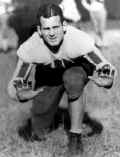 There wasn't many prospects for a poor farmer in rural Arkansas and Bear wanted more than anything to get out of Fordyce. One afternoon while in eighth grade, Paul was watching a varsity football practice when the coach walked up to him and asked him if he knew how to play. Paul explained it was the first time he'd ever seen the game. The coach told Paul, "See that man down there with the ball? You just go down there and try to kill him." Bryant knew how to do that, so when he caught the ball, Bear ran down and destroyed the poor safety. The following Friday he was in the starting lineup.
There wasn't many prospects for a poor farmer in rural Arkansas and Bear wanted more than anything to get out of Fordyce. One afternoon while in eighth grade, Paul was watching a varsity football practice when the coach walked up to him and asked him if he knew how to play. Paul explained it was the first time he'd ever seen the game. The coach told Paul, "See that man down there with the ball? You just go down there and try to kill him." Bryant knew how to do that, so when he caught the ball, Bear ran down and destroyed the poor safety. The following Friday he was in the starting lineup.
Bear played offensive end and defensive tackle. Paul loved the game and the challenges it presented. He was big and strong, but more importantly he had a spirit and intensity rarely displayed by a high school player. He played full-speed every second he was on the field. Paul knew playing football for the Fordyce Redbugs would be his ticket out.
Bryant soon made all-star on a very talented football team that won the state championship in 1930. In fact, one of Fordyce's opponents was Pine Bluff High, which featured a superb end named Don Hudson.
Bryant was enamored of the University of Alabama. He had heard about the Crimson Tide and Wallace Wade who had taken his men to three Rose Bowls. While being recruited, the Arkansas head coach took Bryant to Dallas to a college all-star game, but at the half Bryant slipped out and listened to Alabama beat Washington State 24-0 in the 1931 Rose Bowl.
One day, University of Alabama assistant coach Hank Crisp came to town to recruit Fordyce's talented Jordan twins. Crisp didn't sign the twins but he was impressed enough with Bryant and offered him a scholarship to Alabama. The only problem was Bryant was one class short from graduating. It didn't matter. Bear jumped at the chance to play for the Crimson Tide and moved to campus in 1931. He attended and graduated from Tuscaloosa High while practicing with the Alabama team. He enrolled at Alabama soon after.
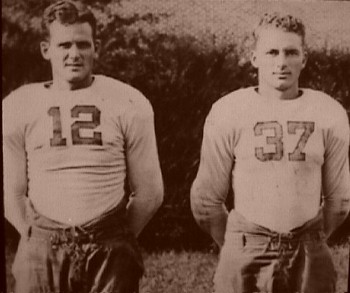 Bryant was a good football player, but was always overshadowed by the legendary Don Hutson, his former high school rival. He was known as "the opposite end" but earned a reputation as a tough player.
Bryant was a good football player, but was always overshadowed by the legendary Don Hutson, his former high school rival. He was known as "the opposite end" but earned a reputation as a tough player.
During a game against Tennessee in 1935, Bryant would display the iron resolution that would become his trademark in years to come by playing with a broken leg. Bryant was magnificent in a 25-0 victory. An Atlanta paper doubting the veracity of the report of the fractured bone requested x-rays to impugn the credibility of the Tide medical staff. The x-rays proved without question, the end named Bear Bryant had indeed competed in an agonizing situation, and had the game of his career.
While Alabama didn't win any national titles during Bryant's playing days, the Tide was one tough team to beat. In 1933 and 1934 Alabama captured the first two SEC Championships and in 1935, upset a very good Stanford team in the Rose Bowl. Known as a tough player, great blocker, and solid catcher, Bryant was selected second-team All-SEC his senior year.
Young Coach
As a player, Bryant was the prototype of the coach he would become. Head Coach Frank Thomas recognized that and hired him as an assistant coach when his playing days ended. Bryant was just 23 years old. He soon married his college sweetheart and campus beauty, Mary Harmon and the couple would soon have two children. After four successful years as assistant coach, Bryant took a job as Red Sanders' number one assistant at Vanderbilt in 1940. Bryant quickly earned a reputation as a demanding coach and strict disciplinarian
A Nation Calls
After the 1941 season, he was invited to be interviewed for the head coaching job at Arkansas.
Sure enough, the job was his. He was only 28 years old. Bryant was driving back home, and he was proud. But the day was December 7, 1941, and he overheard on the car radio that the Japanese had bombed Pearl Harbor. Someone else would have to be head coach at Arkansas.
The very next day, coach Bryant became leuteniant commander Bryant in the U.S. Navy. He was stationed on the USS Uruguay in North Africa. While Bryant saw no actual fighting, he did escape death when his ship was rammed in February, 1943. Many of his shipmates drowned, but Bryant luckily survived.
The Maryland Years
After serving four years in the Navy, it was time for Bear to get back to work and to forge a career in the sport he so dearly loved. He became head coach at the North Carolina Pre-Flight School where he coached All-American QB Otto Graham. George Marshall, owner of the Washington Redskins, offered Bryant an assistant's job, but Bryant wanted to be a head coach. Marshall called Curly Byrd, president of Maryland and recommended Bryant for their vacant head coaching job. Byrd soon offered him the Terps job and at age 32, Bryant was finally a head coach. It was a short-lived tenure, however. Bryant got into a dispute with Byrd after he fired one of his assistants without telling him and reinstated a player Bryant had kicked off the team. Bryant knew he must quit. While looking though a stack of telegrams that evening, he noticed one offering him the head coaching job at Kentucky.
Kentucky Blues
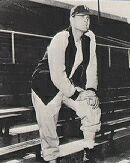 Maryland students, angered at Byrd, went on strike. But Bryant's mind had been made up and he was off to Kentucky. Bryant turned the Wildcats into winners immediately, going 7-3 his first year. His reputation for being brilliant at refining offenses and defenses was starting to form. He lead the Wildcats to their only SEC title in 1950 with a 11-1 record and capped it with an upset over Oklahoma in the Sugar Bowl, snapping their 31 game winning streak. The following year, he added a Cotton Bowl win over TCU. In eight seasons Bryant took Kentucky to four bowls and soon became recognized as one of the brightest young coaches in the country.
Maryland students, angered at Byrd, went on strike. But Bryant's mind had been made up and he was off to Kentucky. Bryant turned the Wildcats into winners immediately, going 7-3 his first year. His reputation for being brilliant at refining offenses and defenses was starting to form. He lead the Wildcats to their only SEC title in 1950 with a 11-1 record and capped it with an upset over Oklahoma in the Sugar Bowl, snapping their 31 game winning streak. The following year, he added a Cotton Bowl win over TCU. In eight seasons Bryant took Kentucky to four bowls and soon became recognized as one of the brightest young coaches in the country.
However, Kentucky was a basketball school lead by legendary basketball coach Adolph Rupp, and football was beginning to rival basketball in popularity. Rupp wanted Kentucky basketball to be number one, and Bryant wanted Kentucky football to be number one. Something had to give. During a Kentucky sports banquet, after both teams won the conference championship, the university presented Rupp with a brand new Cadillac and presented Bryant with a brand new cigarette lighter. Bear knew it was time to move on.
The Aggies' Savior
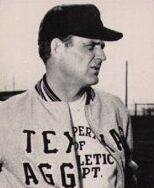 In 1954, he packed up and headed west to Texas A&M. He had the master formula for success, and wanted to test it out at another school. But Bryant inherited an awful program with few good players. Texas A&M was a tough place to lure players to. No girls, no glamour, military uniforms and, at first glance, the school looked more like a penitentiary than a college campus.
In 1954, he packed up and headed west to Texas A&M. He had the master formula for success, and wanted to test it out at another school. But Bryant inherited an awful program with few good players. Texas A&M was a tough place to lure players to. No girls, no glamour, military uniforms and, at first glance, the school looked more like a penitentiary than a college campus.
Bryant knew he had to instill dicipline and toughness in order for A&M to compete. One day during summer practice, he loaded the unsuspecting Aggies in two buses and headed west to Junction, Texas for what was arguably the toughest training camp in football history. Bryant started with 48 players but only came back with 29. Gene Stallings, who was one of Bryant's players at the time, was quoted as saying, "We left in two buses and came back in one, and that one was half full." Bryant put his team through hell at Junction because he wanted to build character and have his players realize that things were going to be done his way.
While his first Texas A&M team had heart, guts, and determination, they finished the season 1-9, Bear's only losing record as a head coach. But the foundation had been layed and in 1956, the Aggies won the Southwest Conference championship. In 1957, halfback John David Crow won the Heisman Trophy, the only player coached by Bryant to receive the honor.
Mama Called
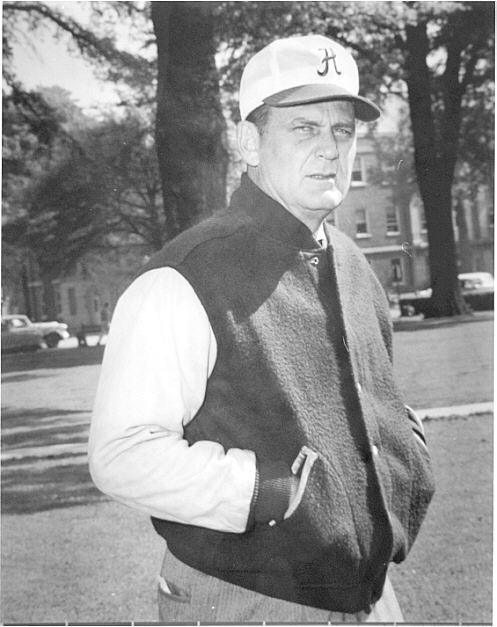 The once proud Alabama football program had fallen on tough times, winning only 4 games in the previous three years.
The decision was made to fire J. B. (Ears) Whitworth after suffering a 28-0 loss to TCU and a 40-0 blowout at the hands of Auburn. A Press Conference was held in the Shamrock Hotel in Houston, Texas, and Paul "Bear" Bryant was announced as the new head coach of the Alabama Crimson Tide. Approximately one month earlier Coach Bryant was in the same hotel meeting with officials about coming to Alabama. A major item that concerned Bryant was the feeling of his former coach and the then athletic director, Hank Crisp. After Coach Crisp assured him that he wanted him to return and the AD's job was his, the deal was sealed. Bryant called a meeting with his A&M players and simply stated, "Gentlemen, I've heard Mama calling," he told them, "and now I'm going home." The Alabama Crimson Tide Football program was about to enjoy a era that may never be matched again in the history of college football.
The once proud Alabama football program had fallen on tough times, winning only 4 games in the previous three years.
The decision was made to fire J. B. (Ears) Whitworth after suffering a 28-0 loss to TCU and a 40-0 blowout at the hands of Auburn. A Press Conference was held in the Shamrock Hotel in Houston, Texas, and Paul "Bear" Bryant was announced as the new head coach of the Alabama Crimson Tide. Approximately one month earlier Coach Bryant was in the same hotel meeting with officials about coming to Alabama. A major item that concerned Bryant was the feeling of his former coach and the then athletic director, Hank Crisp. After Coach Crisp assured him that he wanted him to return and the AD's job was his, the deal was sealed. Bryant called a meeting with his A&M players and simply stated, "Gentlemen, I've heard Mama calling," he told them, "and now I'm going home." The Alabama Crimson Tide Football program was about to enjoy a era that may never be matched again in the history of college football.
Bryant was on his way to Jacksonville where Texas A&M was playing in the Gator Bowl, when he came to Tuscaloosa to meet the football team. The players had heard how tough he was, and how things were going to change. They soon learned after he called a team meeting at the dorm and sent out word for everybody to be there at 1:15 in the afternoon.
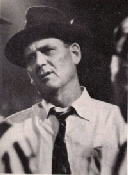 One of Alabama's best players showed up late and was locked out. He started pounding on the door, trying to get in. Coach Bryant turned to his assistant coach and said, "Go see who that is. And tell him, whoever it is, that we don't need him." The team learned right then and there that Bear meant business.
One of Alabama's best players showed up late and was locked out. He started pounding on the door, trying to get in. Coach Bryant turned to his assistant coach and said, "Go see who that is. And tell him, whoever it is, that we don't need him." The team learned right then and there that Bear meant business.
Bryant then said "I'm not worried about whether I'm going to win or lose. I know I'm going to win. I know that. And I'm not worried about my assistant coaches. I know they're winners. And I'm not worried about whether Alabama is going to win. I know that. The only thing I don't know is how many of you in this room are winners, and how many of you will be with us."
Bryant said that he'd be back after the bowl game and that when he got back, they were going to work - and those who were winners would be around to see the rewards, and those who weren't, wouldn't. The players were in awe of him. In fact, they were scared to death of him.
While recruiting his first class, Bryant told his freshmen that if they followed his rules and played they way he demaned, they would win the National Championship before they graduated. Many thought Bryant's statement as just another recruiting tactic.
Building A Winner
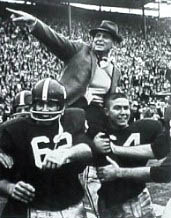 But Bryant turned the program around almost instantly, going 5-4-1. That was more games than Bama had won in the previous 36. His second squad went 7-2-2 and earned a trip to the Liberty Bowl. In 1961, with the help of players like Trammell, Jordan, and Neighbors, Bama went 11-0 and won the National Championship after beating Arkansas in the Sugar Bowl. Bryant's earlier promise to his then freshmen proved accurate. It was the Crimson Tide's sixth National Championship and Bryant's first at the Capstone. In only four years, Paul "Bear" Bryant had revitalized the Crimson Tide football program into the nation's top-ranked college football team once again.
But Bryant turned the program around almost instantly, going 5-4-1. That was more games than Bama had won in the previous 36. His second squad went 7-2-2 and earned a trip to the Liberty Bowl. In 1961, with the help of players like Trammell, Jordan, and Neighbors, Bama went 11-0 and won the National Championship after beating Arkansas in the Sugar Bowl. Bryant's earlier promise to his then freshmen proved accurate. It was the Crimson Tide's sixth National Championship and Bryant's first at the Capstone. In only four years, Paul "Bear" Bryant had revitalized the Crimson Tide football program into the nation's top-ranked college football team once again.
 A young quarterback from Pennsylvania, Joe Namath, was impressed with Bryant's reputation and decided to sign with the Crimson Tide in 1962. Namath suceeded Trammel and would soon become the most famous player to play at the Capstone. Namath threw three touchdown passes in his first game, a 35-0 lashing of Georgia, but the game would become more famous as the subject of a 1963 Saturday Evening Post article charging Bryant and Georgia AD Wally Butts had conspired to "fix" the game.
A young quarterback from Pennsylvania, Joe Namath, was impressed with Bryant's reputation and decided to sign with the Crimson Tide in 1962. Namath suceeded Trammel and would soon become the most famous player to play at the Capstone. Namath threw three touchdown passes in his first game, a 35-0 lashing of Georgia, but the game would become more famous as the subject of a 1963 Saturday Evening Post article charging Bryant and Georgia AD Wally Butts had conspired to "fix" the game.
The accusation infuriated Bryant and both men successfully sued the Post. In fact, it wasn't the first time the Post had targeted Bryant. He had earlier sued over an article that charged him with brutal coaching methods.
National Prominance
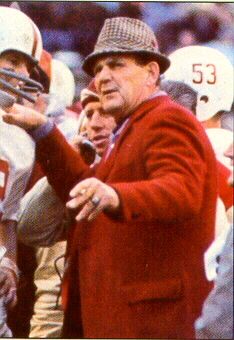 Despite attempts to smear Bryant's reputation, Alabama won it's seventh National Championship in 1964 with Namath at the helm. The Tide repeated as National Champions again in 1965, behind quarterback Steve Sloan. Ken Stabler succeeded him in 1966, but the undefeated Crimson Tide lost the national crown to a Notre Dame team with an inferior record.
Despite attempts to smear Bryant's reputation, Alabama won it's seventh National Championship in 1964 with Namath at the helm. The Tide repeated as National Champions again in 1965, behind quarterback Steve Sloan. Ken Stabler succeeded him in 1966, but the undefeated Crimson Tide lost the national crown to a Notre Dame team with an inferior record.
Alabama would field good teams through the decade of the 60's, going 90-16-4. A 6-5 season in 1969 was the only dissapointment but Bryant had sucessfully revitalized his alma mater, winning three national championships. Alabama was named Team of the Decade and Bryant the Coach of the Decade by an NCAA poll.
Click Here to Listen to Kenny Stabler's Comments About Coach Bryant
"Wishing" For A Change
 Another dissapointing season in 1970 saw the Tide go 6-5-1. Many critics and fans were left wondering if Bryant's magical touch had aged beyond repair. Bryant himself wondered if the college game had passed him by, considering retirement and even entertaining offers from NFL. He knew he had to do something drastic to turn the fortunes of the Tide and secure his legacy at Alabama.
Another dissapointing season in 1970 saw the Tide go 6-5-1. Many critics and fans were left wondering if Bryant's magical touch had aged beyond repair. Bryant himself wondered if the college game had passed him by, considering retirement and even entertaining offers from NFL. He knew he had to do something drastic to turn the fortunes of the Tide and secure his legacy at Alabama.
1971 would be a turning point for Alabama and Bryant in more ways than one. First, Bryant was credited with helping to stimulate the intergration of southern college football, by recruiting Alabama's first black player. Second, Bryant would engineer an offensive change from the pro-attack to the wishbone, thus setting in place a dominance of the 70's.
While the University of Alabama and other southern schools had an intergrated student body for years, no SEC school had a black athlete on their football team. Bryant was by no means a racist, but simply didn't pay much attention issue of intergration, mainly because he continued to win with his formula. Well as evidenced by the previous few years, his formula was in need of adjusting. Bryant saw good black Alabama players were moving out of state, then coming back and beating his teams (witness USC the prior year.) Bryant knew this was an unfair disadvantage and the trend had to change if he was to continue winning. Bryant was credited with helping to stimulate the intergration of southern college football. Within a year, all other SEC schools had black athletes on their roster.
Before the first game of the '71 season, no one could fully realize what mystical adjustment was about to be made by Bryant that would not only rescue sagging spirits but augment himself to a divine level again. Bryant secretly engineered an offensive change from the pro-attack to the wishbone as Bama surprised the heavily favored USC Trojans and won 17-10.
 The wishbone triggered Bryant's dominance of the '70's, winning three more national championships in 1973, 1978, and 1979. Alabama also captured eight SEC Championships in the process. For the decade of the 1970s, the Alabama Crimson Tide compiled an incredible 103-16-1 record. Considering 5 of those losses came in 1970 makes the final nine year stretch of 97-11-0 even more imposing.
The wishbone triggered Bryant's dominance of the '70's, winning three more national championships in 1973, 1978, and 1979. Alabama also captured eight SEC Championships in the process. For the decade of the 1970s, the Alabama Crimson Tide compiled an incredible 103-16-1 record. Considering 5 of those losses came in 1970 makes the final nine year stretch of 97-11-0 even more imposing.
Securing His Legacy
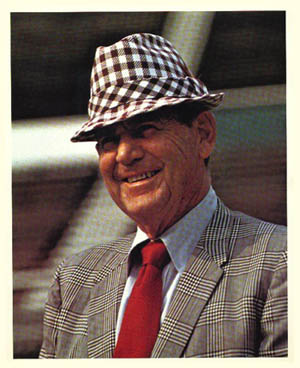 Coach Paul William "Bear" Bryant ascended to the top on major college football's win list (315) November 28, 1981 when his Bama squad rallied for a pair of touchdowns in a 28-17 win over Auburn. Bryant surpassed Amos Alonzo Stagg's previoulsy unbrakeable record of 314 wins. The Year of 315 was a season of intense national media coverage and pressure that was expected to lift Bryant even higher among coaching immortals. the 1981 team also featured a 13th and final SEC title for Bryant at Alabama.
Coach Paul William "Bear" Bryant ascended to the top on major college football's win list (315) November 28, 1981 when his Bama squad rallied for a pair of touchdowns in a 28-17 win over Auburn. Bryant surpassed Amos Alonzo Stagg's previoulsy unbrakeable record of 314 wins. The Year of 315 was a season of intense national media coverage and pressure that was expected to lift Bryant even higher among coaching immortals. the 1981 team also featured a 13th and final SEC title for Bryant at Alabama.
End Of An Era, Beginning Of A Legend
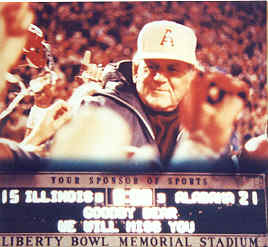 After a dissapointing '82 season, Paul Bryant announced he was retiring at seasons end. He said the decision had come because he wasn't pleased with himself anymore. "This is my school, my alma mater. I love it and I love my players. But in my opinion they deserved better coaching than they have been getting from me this year." On December 29, 1982, sports history was made and an era ended with Bryant's final game, the Liberty Bowl. It was the same bowl he had taken the Tide to in his first year as head coach. In a last rally of respect for the man who had brought the Tide from mediocre to mighty, the boys defeated Illinois twenty-one to fifteen. With three hundred twenty-three career wins, Bryant was lauded as the winningest coach in college football history.
After a dissapointing '82 season, Paul Bryant announced he was retiring at seasons end. He said the decision had come because he wasn't pleased with himself anymore. "This is my school, my alma mater. I love it and I love my players. But in my opinion they deserved better coaching than they have been getting from me this year." On December 29, 1982, sports history was made and an era ended with Bryant's final game, the Liberty Bowl. It was the same bowl he had taken the Tide to in his first year as head coach. In a last rally of respect for the man who had brought the Tide from mediocre to mighty, the boys defeated Illinois twenty-one to fifteen. With three hundred twenty-three career wins, Bryant was lauded as the winningest coach in college football history.
Bryant once said, "I'd probably croak in a week if I ever quit coaching," On January 26, 1983, just 37 days after he had coached his final football game, Paul William "Bear" Bryant died of a heart attack at the age of 69 and a state -- along with a nation, for that matter -- mourned.
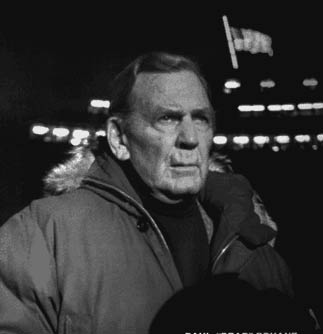 At the funeral, so many people showed up that they filled three churches in downtown Tuscaloosa. The five-mile procession slowly rolled down Tenth Street, past the stadium that for twenty-four years had been filled with fans cheering him on, past Memorial Coliseum where his office was located. Then the somber caravan made its way to I-59, where all traffic stopped to allow its passage. Officials estimated between one-half and one million people lined the fifty-three mile stretch to Elmwood Cemetery in Birmingham, just blocks away from Legion Field.
At the funeral, so many people showed up that they filled three churches in downtown Tuscaloosa. The five-mile procession slowly rolled down Tenth Street, past the stadium that for twenty-four years had been filled with fans cheering him on, past Memorial Coliseum where his office was located. Then the somber caravan made its way to I-59, where all traffic stopped to allow its passage. Officials estimated between one-half and one million people lined the fifty-three mile stretch to Elmwood Cemetery in Birmingham, just blocks away from Legion Field.
Homemade banners hung from the overpasses. Near Bessemer, construction workers in hard hats held up a message scrawled in green paint: "Bear, We Love You and We'll Miss You." Mourners included dozens of Bryant's former players and coaches, along with other famous coaches like Woody Hayes, Frank Broyles, Bobby Dodd, Darrell Royal, John McKay, Eddie Robinson, Duffy Daugherty, Vince Dooley and George Allen. Eight players from Bryant's last team carried the coffin to the grave site. Tributes from both the meek and the famous filled the columns of newspapers nationwide.
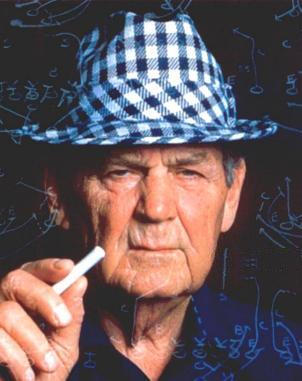 The fabled Bama coach concluded his Tide career with a 232-46-9 record (.824 win %). His 1961, 1964, 1965, 1973, 1978, and 1979 teams all won National Championships. In 1981, he broke Amos Alonzo Stagg's record of 314 coaching victories and finished a combined career record of 323-85-17. Under Bryant, Alabama had 25 winning seasons and was selected for bowl games 24 times. He was named national coach of the year 3 times, SEC coach of the year 10 times and was inducted into the National Football Foundation College Football Hall of Fame in 1986.
The fabled Bama coach concluded his Tide career with a 232-46-9 record (.824 win %). His 1961, 1964, 1965, 1973, 1978, and 1979 teams all won National Championships. In 1981, he broke Amos Alonzo Stagg's record of 314 coaching victories and finished a combined career record of 323-85-17. Under Bryant, Alabama had 25 winning seasons and was selected for bowl games 24 times. He was named national coach of the year 3 times, SEC coach of the year 10 times and was inducted into the National Football Foundation College Football Hall of Fame in 1986.
Coach Bryant was more than a coach, he was a motivator, he knew people and he knew how to get them to play above their expectations. As William Poling said, "Coach Bryant knew more about you than you knew about yourself, he knew when to give you hell, and he knew when to pat you on the back." Florida A&M coach, Jake Gaither said of Coach Bryant, "He can take his'n' and beat you'rn', and he can take you'rn' and beat his'n'." Former Kentucky player, George Blanda often stated, "This must be what God looks like. He'd walk into the room and you wanted to stand up and applaud."
 However, the lives Bryant touched were the most telling witness to his greatness. Bryant understood that there was more to a player than a strong arm or fast legs. The building of character was essential to the building of a winning team. "Intentions over the years were to help the players to be better persons every day, to help themselves, to teach a lesson on and off the field," he said.
However, the lives Bryant touched were the most telling witness to his greatness. Bryant understood that there was more to a player than a strong arm or fast legs. The building of character was essential to the building of a winning team. "Intentions over the years were to help the players to be better persons every day, to help themselves, to teach a lesson on and off the field," he said.
"He was more than the finest football coach who ever lived," former University President Joab Thomas said. "He was a great teacher, a great man and a dear personal friend." Indeed, Paul "Bear" Bryant was all of these things. It was only natural that, in his death, all eyes focused on his life. It was the life of a legend.
Coach Paul "Bear" Bryant. The name was an inspiration in itself, conjuring images of a man in a hounds tooth hat standing by the goal post, coaching his team to yet another victory. Years of experience were etched in his gentle face, but behind the grand fatherly exterior lay what could 'be described as the right stuff, the stuff that created a legend.
Click Here for a Halftime Speech Given by Coach Bryant